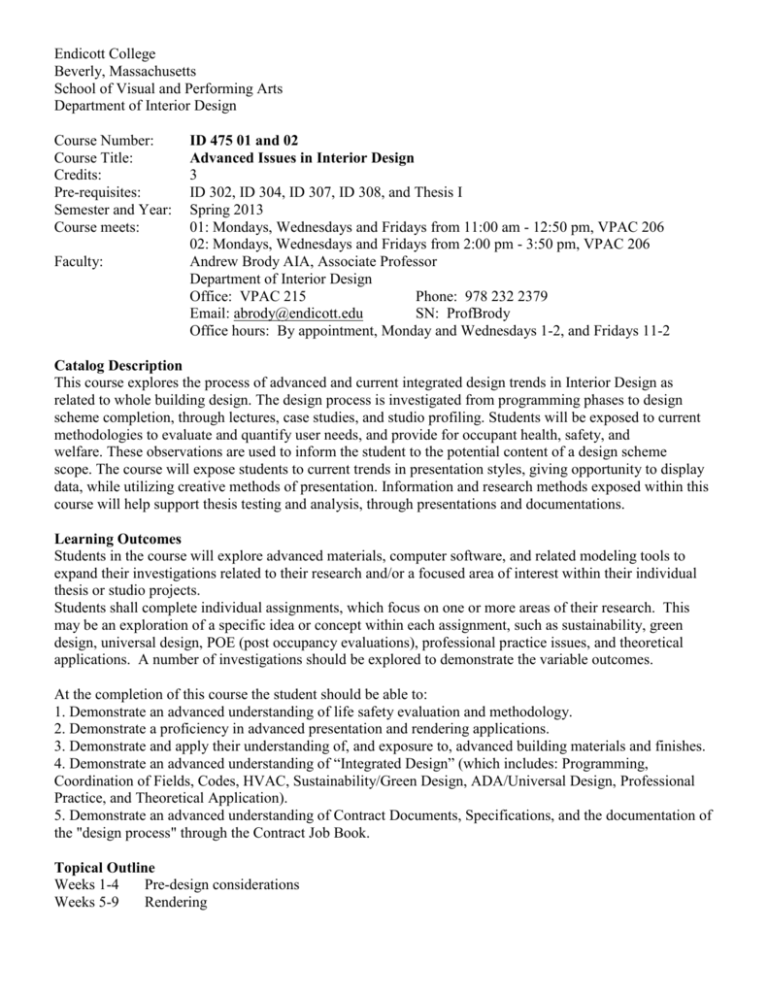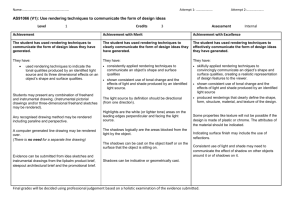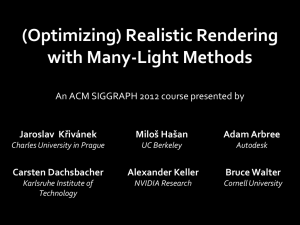Department of Interior Design
advertisement

Endicott College Beverly, Massachusetts School of Visual and Performing Arts Department of Interior Design Course Number: Course Title: Credits: Pre-requisites: Semester and Year: Course meets: Faculty: ID 475 01 and 02 Advanced Issues in Interior Design 3 ID 302, ID 304, ID 307, ID 308, and Thesis I Spring 2013 01: Mondays, Wednesdays and Fridays from 11:00 am - 12:50 pm, VPAC 206 02: Mondays, Wednesdays and Fridays from 2:00 pm - 3:50 pm, VPAC 206 Andrew Brody AIA, Associate Professor Department of Interior Design Office: VPAC 215 Phone: 978 232 2379 Email: abrody@endicott.edu SN: ProfBrody Office hours: By appointment, Monday and Wednesdays 1-2, and Fridays 11-2 Catalog Description This course explores the process of advanced and current integrated design trends in Interior Design as related to whole building design. The design process is investigated from programming phases to design scheme completion, through lectures, case studies, and studio profiling. Students will be exposed to current methodologies to evaluate and quantify user needs, and provide for occupant health, safety, and welfare. These observations are used to inform the student to the potential content of a design scheme scope. The course will expose students to current trends in presentation styles, giving opportunity to display data, while utilizing creative methods of presentation. Information and research methods exposed within this course will help support thesis testing and analysis, through presentations and documentations. Learning Outcomes Students in the course will explore advanced materials, computer software, and related modeling tools to expand their investigations related to their research and/or a focused area of interest within their individual thesis or studio projects. Students shall complete individual assignments, which focus on one or more areas of their research. This may be an exploration of a specific idea or concept within each assignment, such as sustainability, green design, universal design, POE (post occupancy evaluations), professional practice issues, and theoretical applications. A number of investigations should be explored to demonstrate the variable outcomes. At the completion of this course the student should be able to: 1. Demonstrate an advanced understanding of life safety evaluation and methodology. 2. Demonstrate a proficiency in advanced presentation and rendering applications. 3. Demonstrate and apply their understanding of, and exposure to, advanced building materials and finishes. 4. Demonstrate an advanced understanding of “Integrated Design” (which includes: Programming, Coordination of Fields, Codes, HVAC, Sustainability/Green Design, ADA/Universal Design, Professional Practice, and Theoretical Application). 5. Demonstrate an advanced understanding of Contract Documents, Specifications, and the documentation of the "design process" through the Contract Job Book. Topical Outline Weeks 1-4 Pre-design considerations Weeks 5-9 Rendering Weeks 10-13 Compositing and final production Weeks 14-16 NCIDQ preparation Teaching/Learning Strategies Learning objectives will be obtained through a balance of in-class discussions, lectures, exercises, and readings. Required Materials Interior Design Reference Manual, Fifth Edition, David Kent Ballast, Professional Publications Inc. Approximately $25 for boards and printing Recommended Readings NCIDQ Sample Questions for Sections 1, 2, and 3, David Kent Ballast, Professional Publications Inc. 2012 Visual Notes for Architects and Designers, Norman Crowe and Paul Laseau, Wiley, 1984 Mastering AutoDesk 3ds Max Design 2012, Gerhard Harper, Sybex, 2012 Graphic Thinking for Architects and Designers – third edition, Paul Laseau, Wiley, 2001 Illustrations With Photoshop: A Designer’s Notebook, William Rodarmor, O’Reilly, 2005 Evaluation Methods There will be four assignments, weighted equally as part of the final grade. Class participation and attendance will also be considered in assigning the final grade. Grading will be assessed in accordance with Endicott College grading scales (A = 4.0, A- = 3.7, B+ = 3.3, etc.). Project grading will be based on the following criteria: A - Exceptional work, including very high quality research, analysis, design and presentation – taking your work well beyond the outline of the assignment and the goals of the course. B – Completing the assignment thoroughly and fully, with proper formatting, spelling, grammar and evidence of independent and creative thought. Demonstrating thorough knowledge and understanding of the goals of the course. C – Meeting the minimum requirements of the assignment. Demonstrating at least some knowledge and understanding of the goals of the course. D – Partially incomplete or inadequate submittal of the assignment. Demonstrating an insufficient knowledge and understanding of the goals of the course. F – Seriously incomplete or inadequate submittal of the assignment, or a failure to submit an assignment. Demonstrating a lack of knowledge and understanding of the goals of the course. Attendance Policy Attendance is required at each class. Each additional excused or unexcused absence beyond (3) three will result in a drop your final grade. Three tardy arrivals (after 15 minutes late) will be counted as one absence. A student absent or arriving late is responsible for obtaining any information missed in class. Leaving class before it is dismissed will count as one absence. If the Professor has not arrived to class after the first fifteen minutes, students can leave after signing an attendance sheet. Late Work Assignments not handed in by the posted due date will lose one full letter grade for every calendar date it is late. It is the student’s responsibility to ensure that assignments are submitted on time, either brought in by another student or, if permitted by the instructor, submitted electronically. Class Participation It is expected that each student will be a contributing member of the class during semester. Students will also be expected to check GullNET and their campus email before the start of every class – this is how assignments and other announcements will be made. ADA Policy If you as a student qualify as a person with a disability as defined in Chapter 504 of the Rehabilitation Act of 1973, the Americans with Disabilities Act (ADA) of 1990, the Americans with Disabilities Act Amendments Act of 2008 (ADAAA), you are strongly encouraged to register with the Center for Teaching and Learning. The Center for Teaching and Learning is located in the Diane M. Halle Library room 201 and online at www.endicott.edu/academicresources. Academic Integrity Statement Students are required to abide by the Academic Integrity Policy of Endicott College. College Rules and Regulations All rules and regulations printed by Endicott College that apply to this course, will be followed in the administration of this class. Food and Phones No food or drinks in the classroom. Please, please mute and put away your phones off before class begins absolutely no phone conversations or texting in class. Schedule Monday Wednesday Friday 1 Jan 28 Introduction Hand sketching: plans/elevations Hand sketching: perspectives 2 Feb 4 Electronic touch-up and annotation in Illustrator Programming: organization, diagrams of all sorts 3d concept sketching 3 11 3d concept sketching Codes: building Codes: accessibility 4 18 President's Day - no class Work session Pre-design presentation 5 25 Rendering goals; outlining process; Revit rendering review Review SketchUp rendering/Layout Rendering in MAX: modeling 4 Rendering in MAX: importing from SketchUp; manipulating polygons; materials Rendering in MAX: lights; cloning; arrays Rendering in MAX: basic render 7 11 Rendering in MAX: exposure and lighting design 8 18 Spring break Spring break Spring break 9 25 Work session Rendering process diagram Project Manual production (InDesign) 1 Rendering in MAX: importing Rendering in MAX: farming Rendering in MAX: continued 6 10 Mar Apr Review of basic compositing Compositing 11 8 12 15 Patriots day Compositing Compositing 13 22 Rendered animated presentation LEED options and preparation LEED practice 14 29 NCIDQ practice NCIDQ practice NCIDQ practice 6 NCIDQ practice NCIDQ practice NCIDQ practice 13 NCIDQ practice 15 16 May NCIDQ practice exam Assignments Assignment #1: Pre-design presentation Assignment Objective: Create an engaging presentation with information typical of this stage of a project. Format: Electronic slide show. Content: Assignments should contain at least the following: Building description Hand-drawn annotated plan, elevation, and perspectival sketches Project program chart Bubble diagram 3D concept sketch Occupancy estimate Life safety diagram Accessibility issues: overall, project specific Mood board Process: Keep up with the presentations and the in-class activities. Refine the study of your program and other elements of pre-design from the first semester of Thesis. Improve the clarity and quality of your sketched orthographic and perspective drawings, and the subtlety of your program analysis. Identify the major building code and accessibility issues pertinent to your particular project, and assemble the whole kit and caboodle into a clear presentation. Grading criteria: Thorough demonstration and annotation of the different elements for analysis during the pre-design phase of a project. Appropriate quality of images, diagrams, and text, and clear presentation. Assignment #2: Rendering Process Diagram Assignment Objective: Develop workflow to create a project-specific rendering style. Format: Printed, clipped or taped to board Content: Assignments should contain at least the following: Plan of the space you’re rendering Annotated perspectives (at least two) indicating perspectival elements (horizon line, vanishing point(s), and one scale figure Annotated perspective indicating strategy for lighting Annotated perspective indicating strategy for materials Annotated perspective indicating strategy for filtering/layering Annotated perspective indicating strategy for entourage (scale figures, objects, shadows) Final rendering, 12” minimum in smallest dimension Process: Experiments with different perspective angles, materials, lighting techniques, strategies for blending and mixing layers, and entourage styles. Show stages of development of a specific rendering style through test renders and compositional experiments. Create a final composition at 200 ppi resolution (minimum), and compose everything on a board in a manner which makes your process clear. Grading criteria: Thorough demonstration and annotation of the different production stages and processes. Appropriate quality of images and print. Clear demonstration of the process needed to create the desired rendering type. Assignment #3: Rendered animated presentation Assignment Objective: Learn to create a photo-realistically rendering animated presentation Format: Animated, stand-alone presentation of a recent project. Presentation file (AVI or WMV), named using student’s last name (e.g., Brody.wmv). Content: Assignments should contain at least the following: 30 seconds of photo-realistic animation - 720 pixels wide @ 72 PPI, 30 FPS. Titles and credits, Brief description of the project type, building, and location Major program elements indicated in a bubble diagram Annotated floor plan or axonometric Music Four rendered stills (hand or electronic) Process: Develop your thesis project to the point that different sections can be rendered, bot as stills and as animations. For stills, use Revit if you prefer, and render in the style developed in the previous assignment. Bring model into 3ds Max, preferably via SketchUp. Create test renders of stills for lighting, materials and render time. Grab viewport to test animation speed and pacing. Export animation at a low setting, and recombine using the RAM player. Export at final quality and length when ready. Assemble the entire rendering using a movie editor of your choice. Also, save a shorter version in PowerPoint, without animations, for design competition in Rhode Island. Grading criteria: Animation rendered successfully, with complete application of materials and lighting; complexity of image development; composition, coloration, texture, lighting, and applicability to the aesthetic of the design project. Also, animations timing and composition of the walkthrough. Assignment #4: NCIDQ Practice Exam Assignment Objective: Demonstrate knowledge of the body of knowledge needed to be an interior design through selected questions from the NCIDQ exam. Format: Online, in class, on GullNet. Content: Approximately 50 questions, including multiple choice, matching, true/false, etc. All chapter materials, in-class lectures and discussions will be included. Process: Keep up with the reading and the in-class presentations. This will be closed note and closed book. ANY texting, IM, or similar communication is forbidden during the exam, and will result in a zero for the test. Grading criteria: Percentage correct.






